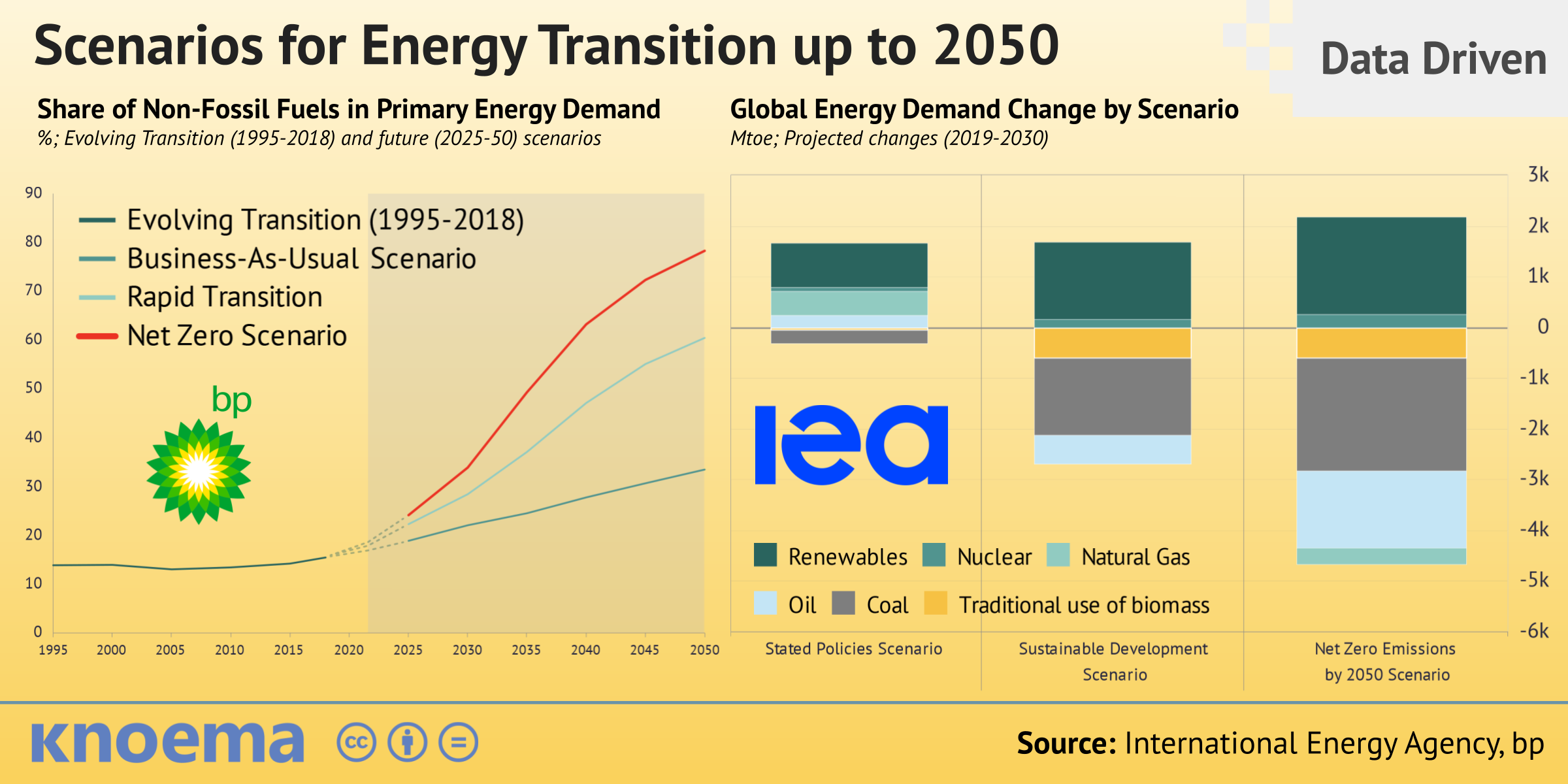当社の個人情報保護方針&クッキーポリシー
当社のウェブサイトではクッキーを使用し、ユーザー様のオンライン体験を向上させております。このウェブサイトを立ち上げたときに、クッキーはお使いのコンピュータ上に配置されます。インターネットブラウザの設定を通して、個人的なクッキーの設定を変更できます。
個人情報保護方針(16 August 2021) In order to limit the rise in global temperatures to the targets established in the Paris agreement, economies need to significantly reduce their greenhouse gas emissions. The most developed countries, as well as the biggest emitters, are announcing targets designed to achieve carbon neutrality by 2050 and even earlier. Achieving these goals, however, will require significantly restructuring of the energy sector to use carbon-free (renewable and nuclear) energy sources and low-carbon fuels (biofuels, hydrogen).
This dashboard presents forecasts from the two leading international agencies, the International Energy Agency (IEA) and BP International, for ongoing changes in energy demand and supply in the coming decades under a variety of scenarios.
The IEA presented two forecasts (the Stated Policies Scenario and the Sustainable Development Scenario) in its September 2020 World Energy Outlook, as well as a third forecast in its Net Zero by 2050 Roadmap published in May 2021. The first two scenarios show the potential future shifts in demand dependent on the degree of future changes that occur. The Roadmap forecast, on the other hand, shows the changes that would need to be implemented in order to reach carbon neutrality by the mid 21st century. Scenario details and visualizations can be found below. Some highlights:
BP International presented three different energy production and consumption scenarios in its 2020 Energy Outlook: Business-As-Usual, Rapid Transition, and Net Zero. Details and visualizations for each scenario can be found below. Highlights:
The Energy Data Brief offers key statistics designed to help energy market watchers anticipate and respond to developments in the energy sector as well as changes in related industries and investments.

(15 June 2021) The US natural gas spot price at Henry Hub, Louisiana — the benchmark price reference for the US natural gas market and an important price reference in global gas trading — will average $3.07 per million British thermal units (MMBtu) in 2021, a 51% increase from the 2020 average, according to the U.S. Energy Information Administration (EIA). The agency attributes this year's price growth to rising liquefied natural gas (LNG) exports and increasing domestic natural gas consumption outside of the power sector. In 2022, Henry Hub prices are expected to decrease to...
(9 February 2021) 2020 was the second hottest year on Earth since the 1880s, according to the 2020 Global Climate Report from The National Centers for Environmental Information. For the northern hemisphere, the 2020 land and ocean surface temperature was the highest ever recorded in the 141-year reporting history at +1.28°C (+2.30°F) above average. This was 0.06°C (0.11°F) higher than the previous record set in 2016. The southern hemisphere was hot last year as well, reporting the fifth highest land and ocean surface temperature on record.
(10 August 2021) "Climate change is irreversible." This was perhaps the most significant conclusion of the most recent report by the Intergovernmental Panel on Climate Change (IPCC). The report, a product of the combined efforts of 234 scientists from 66 countries, projects that in the coming decades climate changes will increase in all regions of the globe, with increasing heat waves, longer warm seasons, and shorter cold seasons. Sea level will continue to rise, and the likelihood of crossing the global temperature increase level of 1.5°C (relative to the preindustrial period,...
(10 June 2021) While 30% of the world's largest corporations have already made a commitment to reducing carbon emissions, there are other companies whose economic activity is inextricably linked to greenhouse gas (GHG) emissions and for whom reducing their carbon footprint is barely feasible — the so-called "carbon majors." In its 2020 Carbon Majors report, the Climate Accountability Institute estimates that between 1965 and 2018, 493 billion tons of greenhouse gases (in CO2 equivalent), or 35% of global GHG emissions from fossil fuels and cement production, were emitted from the...
当社のウェブサイトではクッキーを使用し、ユーザー様のオンライン体験を向上させております。このウェブサイトを立ち上げたときに、クッキーはお使いのコンピュータ上に配置されます。インターネットブラウザの設定を通して、個人的なクッキーの設定を変更できます。
個人情報保護方針